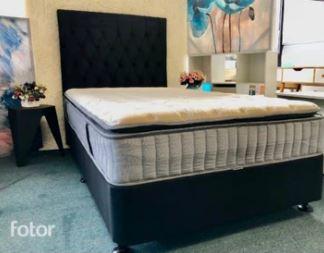The Ultimate Guide to Choosing the Perfect Lounge, Headboards, Base, and Mattress

When it comes to furnishing your home, the choices can often feel endless. But there’s one area where comfort and style are paramount: your bedroom. Creating the perfect space to relax, unwind, and enjoy restful sleep requires attention to detail—and that starts with the right combination of lounge, headboards, bed base and mattress.
In this guide, we’ll explore each of these essential pieces of furniture, providing you with all the information you need to make the best choices for your needs. Whether you’re outfitting a new bedroom or simply upgrading your current setup, this guide will help you understand what to look for when selecting these key components of your bed.
1. The Lounge: A Perfect Spot to Relax
The lounge area in your bedroom or living room is more than just a place to sit; it’s your retreat from the world, where you can relax and unwind. Choosing the right lounge furniture is essential, as it sets the tone for the room’s overall atmosphere and provides a comfortable space for you to relax.
Types of Lounges:
-
Chaise Lounges: A classic piece, a chaise lounge offers long, flowing lines that create an elegant and relaxed atmosphere. Ideal for reading, watching TV, or simply lounging.
-
Recliners: For those who crave ultimate relaxation, a recliner provides the ability to kick back and adjust the seat to your ideal position. Whether you want a more traditional look or a modern recliner with a sleek design, there are plenty of options.
-
Sofas and Sectionals: If you’re looking for a lounge area with more seating, a sofa or sectional may be the best choice. They come in various sizes, from small two-seater options to expansive corner sectionals, allowing you to personalize your space.
Considerations for Lounge Furniture:
-
Size: Make sure the lounge fits well within the space without overcrowding it.
-
Fabric: Choose a fabric that’s easy to clean and complements the rest of the room’s aesthetic.
-
Comfort: Test out the lounge to ensure it’s comfortable for prolonged use.
2. Headboards: The Stylish Statement Piece
The headboard of your bed is more than just a functional piece—it’s a focal point that can make or break the design of your bedroom. Whether you prefer a minimalist style or a more intricate design, the right headboard will complement your bed’s look and enhance your overall bedroom aesthetic.
Types of Headboards:
-
Upholstered Headboards: Soft, padded fabric gives an elegant and cozy feel. Upholstered headboards come in a variety of textures and colors, from velvet to linen, so you can match them with your decor.
-
Wooden Headboards: Wooden headboards are perfect for a rustic or traditional style. They can be solid wood or have intricate carvings that add a touch of craftsmanship to the bed.
-
Metal Headboards: For a sleek and modern aesthetic, metal headboards offer a more industrial and contemporary vibe. They’re often minimalist in design but can still make a bold statement.
Considerations for Choosing a Headboard:
-
Height: Choose a headboard that complements the height of your bed. A taller headboard makes a dramatic statement, while a shorter one creates a more subtle look.
-
Style: Your headboard should match or complement your room’s overall style, from modern to bohemian.
-
Material: Consider how the material will feel against the wall and how easy it will be to maintain.
3. Bed Base: Foundation for a Good Night’s Sleep
The bed base is one of the most important aspects of your bed. It supports the mattress and contributes to your comfort level while sleeping. Different bed bases offer various benefits, and your choice depends on the type of mattress you have and the kind of support you need.
Types of Bed Bases:
-
Platform Beds: These bed bases are solid and provide a strong, even foundation for the mattress. Platform beds don’t require a box spring, and they often come with built-in storage options, which is a great plus for smaller bedrooms.
-
Box Spring Beds: Traditional and classic, a box spring provides additional height and support for your mattress. This option is especially useful for coil mattresses.
-
Adjustable Bed Bases: Perfect for people who need more flexibility, adjustable bases allow you to raise and lower your head or feet. These are especially beneficial for those who experience medical conditions like acid reflux or sleep apnea.
Considerations for Bed Bases:
-
Support Level: Ensure the base provides the right support for your mattress type.
-
Height Preference: Decide whether you prefer a low-profile bed or a higher bed with more storage underneath.
-
Storage Options: If you need extra storage, look for a base that offers drawers or other space-saving solutions.
4. Mattress: The Key to Comfort
The mattress is arguably the most important piece of furniture in your bedroom, as it directly impacts your sleep quality. Choosing the right mattress can improve your comfort, support, and overall health. There are several types of mattresses to choose from, each offering different benefits.
Types of Mattresses:
-
Innerspring Mattresses: Known for their traditional feel, innerspring mattresses have a core of steel coils that provide support. They are bouncy and tend to be cooler than memory foam.
-
Memory Foam Mattresses: These mattresses are known for their ability to contour to the body, providing support and relieving pressure points. They’re great for side sleepers or people with back pain.
-
Hybrid Mattresses: A combination of innerspring and memory foam, hybrid mattresses provide the best of both worlds—support and contouring comfort.
-
Latex Mattresses: Made from natural or synthetic rubber, latex mattresses are durable, breathable, and offer a firmer feel. They’re great for people who need extra support but don’t like the sinking feeling of memory foam.
Considerations for Mattresses:
-
Firmness Level: This depends on your sleeping position and personal preference. Side sleepers often prefer a softer mattress, while back and stomach sleepers typically need firmer support.
-
Allergies: If you have allergies, consider hypoallergenic materials such as latex or specialized memory foam.
-
Durability: A quality mattress can last anywhere from 7 to 10 years. Make sure to invest in a durable option that won’t wear out too quickly.
FAQ
Q1: What type of mattress is best for back pain?
A firm mattress with good support is typically the best choice for back pain. Memory foam or hybrid mattresses are often recommended, as they provide the necessary support while contouring to the body’s shape.
Q2: Can I use an old bed base with a new mattress?
It depends on the type of mattress you have. A platform bed or box spring that is still in good condition can be used with most mattresses, but it’s important to ensure the base provides the right support for your mattress.
Q3: How do I choose the right size lounge for my room?
Measure the available space in your room and consider the furniture layout. It’s best to leave some walking space around the lounge to avoid overcrowding.
Q4: What’s the difference between a platform bed and a box spring bed?
A platform bed provides a solid, flat surface for your mattress, while a box spring has a spring structure that provides additional height and support, often used with innerspring mattresses.
With so many options for lounges, headboards, bed bases, and mattresses, creating a cozy, stylish, and functional bedroom is more attainable than ever. By considering your personal preferences, space, and comfort needs, you can make the right choices that ensure restful sleep and a welcoming atmosphere for years to come. Happy decorating!







